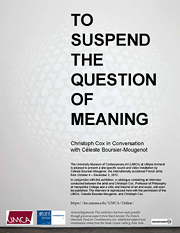October 1st 2012
Re: Céleste Boursier‐Mougenot at UMCA Oct 4 – Dec 2 2012
From: Artist Organized Art
To: The Subscriber Email Address
Subscribe | Unsubscribe | Join us on Facebook or Google+
Céleste Boursier‐Mougenot at UMCA Oct 4 – Dec 2 2012
To Suspend The Question of Meaning
Christoph Cox in Conversation with Céleste Boursier‐Mougenot
The University Museum of Contemporary Art (UMCA) at UMass Amherst

Cover: 2008 catalogue; itself an adapted work by Céleste Boursier‐Mougenot, Available through
Paula Cooper Gallery, extended sound samples: http://www.analogues.fr/indexinprogress
The University Museum of Contemporary Art (UMCA) at UMass Amherst is pleased to present a site-specific sound and video installation by Céleste Boursier‐Mougenot, the internationally acclaimed French artist, from October 4 – December 2, 2012. In conjunction with this exhibition, a catalogue containing an interview conducted between the artist and Christoph Cox, Professor of Philosophy at Hampshire College and a critic and theorist of art and music, will soon be published. The interview is reproduced here with the permission of the UMCA, Céleste Boursier‐Mougenot, and Christoph Cox. https://fac.umass.edu/UMCA/Online/ Acknowledgements: This exhibition has been made possible through generous support from Etant donnés: The French-American Fund for Contemporary Art. Additional support and coordination comes from the Paula Cooper Gallery, New York.
The Entire Interview: (Read It Here)
EXCERPTS:
Christoph Cox: You began your career as a musician and composer. What prompted your move into sound installation and the context of the visual arts?
Céleste Boursier‐Mougenot: I’ve always been immersed in the visual arts and aesthetic considerations because my family is very connected to the arts. My great grandfather was a passionate landscape photographer who worked with daguerreotypes. His son, my grandfather, was a painter and illustrator who made some animated films. My father made stained glass for churches, made sculpture and mosaics for public art projects, and later became a sort of garden historian. My parents considered all forms of art and literature to be really important. Their artist and writer friends often visited and stayed with us.
The concept of space (broadly considered) was also a recurrent interest for all of us. One of my brothers, who was interested in mapping, studied engineering and topographical geography. Another brother is a landscape architect. My mother worked as a sociological urbanist. So it’s also quite natural that I’ve considered the notion of space and integrated it into my musical practice.
At home, we listened to all kinds of music (classical, ethnic, rock and pop, experimental, free jazz etc.) and went to musical performances, art exhibitions, and movies every week. I grew up without a TV. When I was about twenty years old and got my own apartment, I bought my first TV. Instead of working on my music projects, I spent so much time watching it at night that I finally threw it away. I kept in the back of my mind that some day I would do a project that would reverse the passivity of TV watching and pull viewers somewhere else, into a space where they have to identify what they are watching. (This eventually resulted in zombiedrones. Many of my works have roots in questions, thoughts, or ideas I had a long time ago. It took me more than 15 years to get the means to start my index piano project.)
CC: When you transpose or transduce one form or media into another, the two forms have to be linked closely enough that the transposition doesn’t seem arbitrary; but they also have to be distant enough so that something surprising or enigmatic is revealed in the process. How do you balance between these two constraints?
CBM: Yes, you’re right, constraint is the master word of my practice. Usually I restrict myself to one material and one process to extract the sound or musical field of the work. The architecture of the presentation space is also an effective constraint by which works can be transformed. The Amherst exhibition is the first to present a set of my works in the same space.
CC: Many of your works are generative structures that establish a situation and then leave it to operate on its own. This makes me think of experimental composers such as Steve Reich (e.g., Come Out) and Alvin Lucier (e.g., I Am Sitting in a Room) who, in the 1960s and 70s, developed an interest in generative music. Are those figures influences for you?
CBM: I’ve been influenced by so many artists’ works that to speak about these ones instead of others seems to me unfair. I think that the domain of influences can remain private. Research into causality or paternity doesn’t really interest me. (I have my own father and am myself the father of four kids!) The feedback effect in my practice in a way tries to disrupt this line of thinking. It seems to me that concrete stories or memories about the works are often more interesting than theoretical references. It’s also that I’ve been disappointed by certain artists who constantly refer to established works, but whose own work is not as interesting as their talk about it. If an art critic or historian sees a correlation, that does not disturb me. But I like it when people can havean aesthetic experience without reference to art history.
CC: The idea that there is music waiting to be revealed everywhere seems to me to connect with a recent artistic and curatorial interest in animism and the life of things.
CBM: I often say that I’m a techno-animist, and that my work is dedicated to the “living.”
Artist Organized Art
243 5th Avenue, Suite 248, New York, NY 10016, USA
http://artistorganizedart.org/commons

